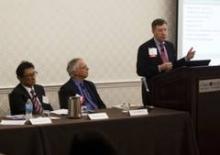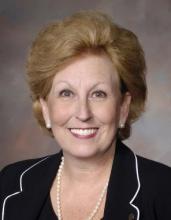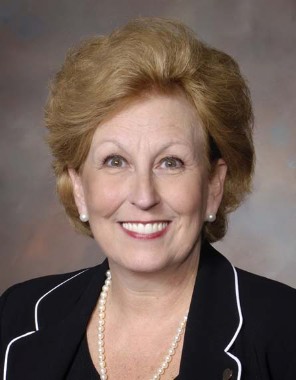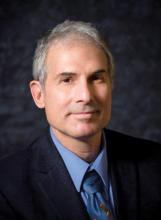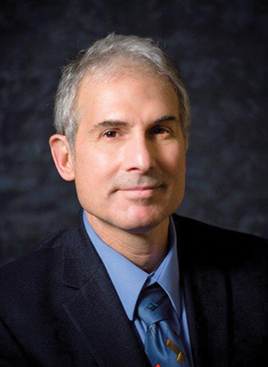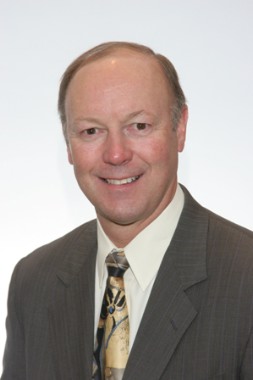User login
Hospitals innovate to avoid Medicare readmissions penalties
WASHINGTON – A Medicare penalty for too many patient readmissions has led physicians and hospitals to adopt new strategies that prevent returns to the emergency department.
Fines of $227 million will be levied against 2,225 hospitals during the 2014 fiscal year that began Oct. 1. About 1,300 other hospitals will avoid penalties.
NCH Healthcare System in Naples, Fla., is a system with two hospitals that has not been penalized, said Dr. Allen Weiss, president and CEO. The secret to success so far has been use of robust health information technology, standardization of best practices, and identifying those at risk of a readmission.
"During the hospitalization we can tell who is most likely to be readmitted," Dr. Weiss said. "It’s not rocket science when you start to identify your high-risk folks. Then you direct attention toward them and drill down on a root-cause analysis."
Typically, the hospital system staff will find a medication error during a reconciliation check. The hospital has addressed this type of problem by providing patients access to a pharmacist before discharge and education about the medicine. The pharmacist will then "teach back" the education by asking the patient about what has been prescribed.
"We also are doing follow-up calls for patient satisfaction, to see if they got their medications and if they have made a follow-up appointment with their primary care physician," Dr. Weiss said. "It sounds easier than it actually is."
Medicare began to penalize hospitals for excessive readmission rates in October 2012. The penalty attempts to incentivize hospitals to lower 30-day readmissions for heart attack, heart failure, and pneumonia. Initially, the move amounted to a maximum of 1% of Medicare pay.
In fiscal year 2014, the penalty rises to 2%, and in 2015 the Medicare agency is expected to add hip and knee surgery and chronic obstructive pulmonary disease to the list of conditions used to measure performance.
Physicians and hospitals face challenges with patients who have multiple chronic conditions and social problems. Safety net hospitals have been hit disproportionately with penalties, panelists said at the Hospital of Tomorrow meeting, which was sponsored by U.S News and World Report.
Hospitals are allocating resources differently to address problems. Baylor Scott & White Health in Texas has helped care for diabetic patients in a poor section of southern Dallas by investing in a fitness center, which includes a demonstration kitchen to teach patients how to cook healthy meals, said Joel Allison, president and CEO of the 43-hospital system. The center also hosts a farm stand to provide fruits and vegetables at a low cost.
"We’re 85 percent unfunded but we feel like it’s the right thing to do," Mr. Allison said. "It’s helping to improve the health of that community."
Baylor Scott & White Health also will work with patient-centered medical homes to treat individuals who present in the emergency department with a problem that can be treated in a clinic. This avoids the potential problem of the patient waiting a long time in the ED and then being admitted because the issue was not addressed right away.
Good data also are key to preventing readmissions, said Dr. Clifford Ko, a surgeon at UCLA Jonsson Comprehensive Cancer Center in Los Angeles. Dr. Ko is director of the American College of Surgeons National Surgical Quality Improvement Program and Division of Research and Optimal Patient Care.
Readmissions following surgery often are due to complications stemming from the primary procedure, Dr. Ko said. Surgeons can expect more quality measures aimed at reducing readmissions.
"We are going to have less administrative claims measures and probably more registry-based measures," Dr. Ko said.
WASHINGTON – A Medicare penalty for too many patient readmissions has led physicians and hospitals to adopt new strategies that prevent returns to the emergency department.
Fines of $227 million will be levied against 2,225 hospitals during the 2014 fiscal year that began Oct. 1. About 1,300 other hospitals will avoid penalties.
NCH Healthcare System in Naples, Fla., is a system with two hospitals that has not been penalized, said Dr. Allen Weiss, president and CEO. The secret to success so far has been use of robust health information technology, standardization of best practices, and identifying those at risk of a readmission.
"During the hospitalization we can tell who is most likely to be readmitted," Dr. Weiss said. "It’s not rocket science when you start to identify your high-risk folks. Then you direct attention toward them and drill down on a root-cause analysis."
Typically, the hospital system staff will find a medication error during a reconciliation check. The hospital has addressed this type of problem by providing patients access to a pharmacist before discharge and education about the medicine. The pharmacist will then "teach back" the education by asking the patient about what has been prescribed.
"We also are doing follow-up calls for patient satisfaction, to see if they got their medications and if they have made a follow-up appointment with their primary care physician," Dr. Weiss said. "It sounds easier than it actually is."
Medicare began to penalize hospitals for excessive readmission rates in October 2012. The penalty attempts to incentivize hospitals to lower 30-day readmissions for heart attack, heart failure, and pneumonia. Initially, the move amounted to a maximum of 1% of Medicare pay.
In fiscal year 2014, the penalty rises to 2%, and in 2015 the Medicare agency is expected to add hip and knee surgery and chronic obstructive pulmonary disease to the list of conditions used to measure performance.
Physicians and hospitals face challenges with patients who have multiple chronic conditions and social problems. Safety net hospitals have been hit disproportionately with penalties, panelists said at the Hospital of Tomorrow meeting, which was sponsored by U.S News and World Report.
Hospitals are allocating resources differently to address problems. Baylor Scott & White Health in Texas has helped care for diabetic patients in a poor section of southern Dallas by investing in a fitness center, which includes a demonstration kitchen to teach patients how to cook healthy meals, said Joel Allison, president and CEO of the 43-hospital system. The center also hosts a farm stand to provide fruits and vegetables at a low cost.
"We’re 85 percent unfunded but we feel like it’s the right thing to do," Mr. Allison said. "It’s helping to improve the health of that community."
Baylor Scott & White Health also will work with patient-centered medical homes to treat individuals who present in the emergency department with a problem that can be treated in a clinic. This avoids the potential problem of the patient waiting a long time in the ED and then being admitted because the issue was not addressed right away.
Good data also are key to preventing readmissions, said Dr. Clifford Ko, a surgeon at UCLA Jonsson Comprehensive Cancer Center in Los Angeles. Dr. Ko is director of the American College of Surgeons National Surgical Quality Improvement Program and Division of Research and Optimal Patient Care.
Readmissions following surgery often are due to complications stemming from the primary procedure, Dr. Ko said. Surgeons can expect more quality measures aimed at reducing readmissions.
"We are going to have less administrative claims measures and probably more registry-based measures," Dr. Ko said.
WASHINGTON – A Medicare penalty for too many patient readmissions has led physicians and hospitals to adopt new strategies that prevent returns to the emergency department.
Fines of $227 million will be levied against 2,225 hospitals during the 2014 fiscal year that began Oct. 1. About 1,300 other hospitals will avoid penalties.
NCH Healthcare System in Naples, Fla., is a system with two hospitals that has not been penalized, said Dr. Allen Weiss, president and CEO. The secret to success so far has been use of robust health information technology, standardization of best practices, and identifying those at risk of a readmission.
"During the hospitalization we can tell who is most likely to be readmitted," Dr. Weiss said. "It’s not rocket science when you start to identify your high-risk folks. Then you direct attention toward them and drill down on a root-cause analysis."
Typically, the hospital system staff will find a medication error during a reconciliation check. The hospital has addressed this type of problem by providing patients access to a pharmacist before discharge and education about the medicine. The pharmacist will then "teach back" the education by asking the patient about what has been prescribed.
"We also are doing follow-up calls for patient satisfaction, to see if they got their medications and if they have made a follow-up appointment with their primary care physician," Dr. Weiss said. "It sounds easier than it actually is."
Medicare began to penalize hospitals for excessive readmission rates in October 2012. The penalty attempts to incentivize hospitals to lower 30-day readmissions for heart attack, heart failure, and pneumonia. Initially, the move amounted to a maximum of 1% of Medicare pay.
In fiscal year 2014, the penalty rises to 2%, and in 2015 the Medicare agency is expected to add hip and knee surgery and chronic obstructive pulmonary disease to the list of conditions used to measure performance.
Physicians and hospitals face challenges with patients who have multiple chronic conditions and social problems. Safety net hospitals have been hit disproportionately with penalties, panelists said at the Hospital of Tomorrow meeting, which was sponsored by U.S News and World Report.
Hospitals are allocating resources differently to address problems. Baylor Scott & White Health in Texas has helped care for diabetic patients in a poor section of southern Dallas by investing in a fitness center, which includes a demonstration kitchen to teach patients how to cook healthy meals, said Joel Allison, president and CEO of the 43-hospital system. The center also hosts a farm stand to provide fruits and vegetables at a low cost.
"We’re 85 percent unfunded but we feel like it’s the right thing to do," Mr. Allison said. "It’s helping to improve the health of that community."
Baylor Scott & White Health also will work with patient-centered medical homes to treat individuals who present in the emergency department with a problem that can be treated in a clinic. This avoids the potential problem of the patient waiting a long time in the ED and then being admitted because the issue was not addressed right away.
Good data also are key to preventing readmissions, said Dr. Clifford Ko, a surgeon at UCLA Jonsson Comprehensive Cancer Center in Los Angeles. Dr. Ko is director of the American College of Surgeons National Surgical Quality Improvement Program and Division of Research and Optimal Patient Care.
Readmissions following surgery often are due to complications stemming from the primary procedure, Dr. Ko said. Surgeons can expect more quality measures aimed at reducing readmissions.
"We are going to have less administrative claims measures and probably more registry-based measures," Dr. Ko said.
AT THE HOSPITAL OF TOMORROW MEETING
Physicians alarmed by high rate of Medicare claims denied in error
As Medicare auditors have increased their workloads in recent years, doctors and hospitals are appealing more decisions that deny claims for beneficiary services.
Physicians sought to overturn denials 1.5 million times in 2012, which represented a 9% increase since 2008, according to an October report from the Health and Human Services department’s Office of Inspector General (OIG). Hospitals have appealed far fewer denied claims, but Medicare auditors, such as Recovery Audit Contractors (RACs), are driving more inpatient providers to enter the redetermination process, the OIG reported.
Physicians continue to have serious concerns about the inaccuracy of Medicare audit contractors, according to Dr. Ardis Dee Hoven, president of the American Medical Association.
The OIG’s report pointed out that "physicians who invest the time and expense to dispute contractor determinations prevail 54% of the time at the first level of appeal," Dr. Hoven said. "This contractor error rate is far too high, and physician practices should not have to undergo burdensome audits – including RAC audits – while this problem remains unaddressed."
Medicare processed more than 1.2 billion claims and denied nearly 140 million of them in 2012. Of those, 2.6% were appealed via the first-level appeals process. The OIG report did not provide details on why physician claims were denied; however, many Part A hospital benefit appeals stemmed from a RAC decision regarding short-term inpatient hospital stays.
The Centers for Medicare and Medicaid Services is implementing a new appeals system that soon will offer more information about appeals. Four contractors have begun using the system to process Part A redeterminations this year, CMS administrator Marilyn Tavenner said in an August memo to the OIG.
Contractors largely meet the timeframes established for redetermination requests, which is good news to practices that actively appeal claims, said Kent Moore, senior physician payment strategist at the American Academy of Family Physicians.
"If you appeal and you’re successful, you can get your money in a timely manner," Mr. Moore said. "If you’re not successful, then it might take longer than expected."
The OIG report found for favorably appealed claims, contractors paid physicians within 30 days 93% of the time. However, denied claims that are appealed to a second level can take 6 months to decide. In 2012, contractors transferred more than 280,000 Part B claims to the second level.
As Medicare auditors have increased their workloads in recent years, doctors and hospitals are appealing more decisions that deny claims for beneficiary services.
Physicians sought to overturn denials 1.5 million times in 2012, which represented a 9% increase since 2008, according to an October report from the Health and Human Services department’s Office of Inspector General (OIG). Hospitals have appealed far fewer denied claims, but Medicare auditors, such as Recovery Audit Contractors (RACs), are driving more inpatient providers to enter the redetermination process, the OIG reported.
Physicians continue to have serious concerns about the inaccuracy of Medicare audit contractors, according to Dr. Ardis Dee Hoven, president of the American Medical Association.
The OIG’s report pointed out that "physicians who invest the time and expense to dispute contractor determinations prevail 54% of the time at the first level of appeal," Dr. Hoven said. "This contractor error rate is far too high, and physician practices should not have to undergo burdensome audits – including RAC audits – while this problem remains unaddressed."
Medicare processed more than 1.2 billion claims and denied nearly 140 million of them in 2012. Of those, 2.6% were appealed via the first-level appeals process. The OIG report did not provide details on why physician claims were denied; however, many Part A hospital benefit appeals stemmed from a RAC decision regarding short-term inpatient hospital stays.
The Centers for Medicare and Medicaid Services is implementing a new appeals system that soon will offer more information about appeals. Four contractors have begun using the system to process Part A redeterminations this year, CMS administrator Marilyn Tavenner said in an August memo to the OIG.
Contractors largely meet the timeframes established for redetermination requests, which is good news to practices that actively appeal claims, said Kent Moore, senior physician payment strategist at the American Academy of Family Physicians.
"If you appeal and you’re successful, you can get your money in a timely manner," Mr. Moore said. "If you’re not successful, then it might take longer than expected."
The OIG report found for favorably appealed claims, contractors paid physicians within 30 days 93% of the time. However, denied claims that are appealed to a second level can take 6 months to decide. In 2012, contractors transferred more than 280,000 Part B claims to the second level.
As Medicare auditors have increased their workloads in recent years, doctors and hospitals are appealing more decisions that deny claims for beneficiary services.
Physicians sought to overturn denials 1.5 million times in 2012, which represented a 9% increase since 2008, according to an October report from the Health and Human Services department’s Office of Inspector General (OIG). Hospitals have appealed far fewer denied claims, but Medicare auditors, such as Recovery Audit Contractors (RACs), are driving more inpatient providers to enter the redetermination process, the OIG reported.
Physicians continue to have serious concerns about the inaccuracy of Medicare audit contractors, according to Dr. Ardis Dee Hoven, president of the American Medical Association.
The OIG’s report pointed out that "physicians who invest the time and expense to dispute contractor determinations prevail 54% of the time at the first level of appeal," Dr. Hoven said. "This contractor error rate is far too high, and physician practices should not have to undergo burdensome audits – including RAC audits – while this problem remains unaddressed."
Medicare processed more than 1.2 billion claims and denied nearly 140 million of them in 2012. Of those, 2.6% were appealed via the first-level appeals process. The OIG report did not provide details on why physician claims were denied; however, many Part A hospital benefit appeals stemmed from a RAC decision regarding short-term inpatient hospital stays.
The Centers for Medicare and Medicaid Services is implementing a new appeals system that soon will offer more information about appeals. Four contractors have begun using the system to process Part A redeterminations this year, CMS administrator Marilyn Tavenner said in an August memo to the OIG.
Contractors largely meet the timeframes established for redetermination requests, which is good news to practices that actively appeal claims, said Kent Moore, senior physician payment strategist at the American Academy of Family Physicians.
"If you appeal and you’re successful, you can get your money in a timely manner," Mr. Moore said. "If you’re not successful, then it might take longer than expected."
The OIG report found for favorably appealed claims, contractors paid physicians within 30 days 93% of the time. However, denied claims that are appealed to a second level can take 6 months to decide. In 2012, contractors transferred more than 280,000 Part B claims to the second level.
CMS two-midnight rule begins, but audits are on hold
The Centers for Medicare and Medicaid Services has delayed through December enforcement of its new two-midnight rule, which went into effect Oct. 1. The rule change is an attempt to clarify admission and medical review criteria for inpatient services, while also addressing the growing trend of patients being held in observation for lengthy periods of time.
The new policy states that when a patient’s stay in the hospital surpasses two midnights, the patient is presumed to be an inpatient. Services for patients staying fewer than two midnights are presumed to be provided in the outpatient setting.
Reactions to the policy from providers have been mixed. Hospitals have fiercely opposed the change, which included across-the-board cuts to inpatient Medicare reimbursements.
"The two-midnight rule makes it pretty transparent," said Dr. Evan Pollack, an internist who practices near Philadelphia and is cochair of the American College of Physicians health and public policy committee in Pennsylvania. "I think this brings the decision making back to the treating physician. If you’re not planning to send the patient home the next day, it’s still your decision to admit him."
The policy also takes aim at shorter inpatient hospital stays and could save the Medicare program money, Dr. Pollack said.
At one hospital, data have shown more patients would lose inpatient status than gain it under the new policy, said Dr. Ann Sheehy, who heads the hospital medicine division at the University of Wisconsin in Madison. Dr. Sheehy and her colleagues recently studied observation – which is technically an outpatient service – as well as inpatient stays, at the University of Wisconsin Hospital from July 2010 through December 2011, and determined how many patients would have been affected by the two-midnight rule. They concluded that the hospital would have lost $14.6 million in reimbursements during that period because many more short hospital stays would have been converted to observation stays, for which payments are significantly less than for inpatient services.
The study counters a CMS projection finding the policy will cost the Medicare program $220 million. The agency has offset the amount by reducing hospital payments elsewhere by 0.2%.
Although the data showed the University of Wisconsin Hospital losing Medicare pay, Dr. Sheehy said that the policy change may cost Medicare ultimately. Physician and patient behavior patterns could change as more become aware of the two-midnight benchmark.
"There will be longer stays that are more expensive," Dr. Sheehy said. "Patients will know about the rule and want to stay for another midnight in order to avoid cost-sharing fees. Some will end up staying two midnights because [providers] fear being audited."
Many patients will fall into a "gray area" when spending 26-47 hours in the hospital, she added. Whether some patients cross the two-midnight threshold will depend on the time of day they arrive at the hospital. Patients arriving at 11 p.m., for example, will have shorter stays before reaching two midnights than will others presenting in the morning.
"When rules look like that, it opens the process up to manipulation," Dr. Sheehy said. "Everyone will look at it and ask, ‘How can we get to two midnights?’"
For now, the CMS has instructed Medicare Administrative Contractors and Recovery Audit Contractors to not target hospital inpatient status during reviews for claims with dates of service between Oct. 1 and Dec. 31, according to an agency frequently asked questions page. But the CMS will allow contractors to audit 10-25 cases per hospital during that time for educational purposes.
"We feel it’s giving them a running start," Dr. Sheehy said. Recovery Audit Contractors "will know which hospitals are having problems and go after them in January."
The rule also has faced opposition from Congress. In September, a bipartisan group of more than 100 House members sent a letter to CMS Administrator Marilyn Tavenner urging a 6-month delay to the rule. Patients may face higher out-of-pocket costs while hospitals also have not had enough time to educate providers about the rule.
"We are concerned that hospitals in our districts could be undercompensated for providing medically necessary services that do not meet the new criteria spelled out by the CMS and face administrative challenges in complying with new requirements," the letter stated.
This story was updated 10/15/2013.
The Centers for Medicare and Medicaid Services has delayed through December enforcement of its new two-midnight rule, which went into effect Oct. 1. The rule change is an attempt to clarify admission and medical review criteria for inpatient services, while also addressing the growing trend of patients being held in observation for lengthy periods of time.
The new policy states that when a patient’s stay in the hospital surpasses two midnights, the patient is presumed to be an inpatient. Services for patients staying fewer than two midnights are presumed to be provided in the outpatient setting.
Reactions to the policy from providers have been mixed. Hospitals have fiercely opposed the change, which included across-the-board cuts to inpatient Medicare reimbursements.
"The two-midnight rule makes it pretty transparent," said Dr. Evan Pollack, an internist who practices near Philadelphia and is cochair of the American College of Physicians health and public policy committee in Pennsylvania. "I think this brings the decision making back to the treating physician. If you’re not planning to send the patient home the next day, it’s still your decision to admit him."
The policy also takes aim at shorter inpatient hospital stays and could save the Medicare program money, Dr. Pollack said.
At one hospital, data have shown more patients would lose inpatient status than gain it under the new policy, said Dr. Ann Sheehy, who heads the hospital medicine division at the University of Wisconsin in Madison. Dr. Sheehy and her colleagues recently studied observation – which is technically an outpatient service – as well as inpatient stays, at the University of Wisconsin Hospital from July 2010 through December 2011, and determined how many patients would have been affected by the two-midnight rule. They concluded that the hospital would have lost $14.6 million in reimbursements during that period because many more short hospital stays would have been converted to observation stays, for which payments are significantly less than for inpatient services.
The study counters a CMS projection finding the policy will cost the Medicare program $220 million. The agency has offset the amount by reducing hospital payments elsewhere by 0.2%.
Although the data showed the University of Wisconsin Hospital losing Medicare pay, Dr. Sheehy said that the policy change may cost Medicare ultimately. Physician and patient behavior patterns could change as more become aware of the two-midnight benchmark.
"There will be longer stays that are more expensive," Dr. Sheehy said. "Patients will know about the rule and want to stay for another midnight in order to avoid cost-sharing fees. Some will end up staying two midnights because [providers] fear being audited."
Many patients will fall into a "gray area" when spending 26-47 hours in the hospital, she added. Whether some patients cross the two-midnight threshold will depend on the time of day they arrive at the hospital. Patients arriving at 11 p.m., for example, will have shorter stays before reaching two midnights than will others presenting in the morning.
"When rules look like that, it opens the process up to manipulation," Dr. Sheehy said. "Everyone will look at it and ask, ‘How can we get to two midnights?’"
For now, the CMS has instructed Medicare Administrative Contractors and Recovery Audit Contractors to not target hospital inpatient status during reviews for claims with dates of service between Oct. 1 and Dec. 31, according to an agency frequently asked questions page. But the CMS will allow contractors to audit 10-25 cases per hospital during that time for educational purposes.
"We feel it’s giving them a running start," Dr. Sheehy said. Recovery Audit Contractors "will know which hospitals are having problems and go after them in January."
The rule also has faced opposition from Congress. In September, a bipartisan group of more than 100 House members sent a letter to CMS Administrator Marilyn Tavenner urging a 6-month delay to the rule. Patients may face higher out-of-pocket costs while hospitals also have not had enough time to educate providers about the rule.
"We are concerned that hospitals in our districts could be undercompensated for providing medically necessary services that do not meet the new criteria spelled out by the CMS and face administrative challenges in complying with new requirements," the letter stated.
This story was updated 10/15/2013.
The Centers for Medicare and Medicaid Services has delayed through December enforcement of its new two-midnight rule, which went into effect Oct. 1. The rule change is an attempt to clarify admission and medical review criteria for inpatient services, while also addressing the growing trend of patients being held in observation for lengthy periods of time.
The new policy states that when a patient’s stay in the hospital surpasses two midnights, the patient is presumed to be an inpatient. Services for patients staying fewer than two midnights are presumed to be provided in the outpatient setting.
Reactions to the policy from providers have been mixed. Hospitals have fiercely opposed the change, which included across-the-board cuts to inpatient Medicare reimbursements.
"The two-midnight rule makes it pretty transparent," said Dr. Evan Pollack, an internist who practices near Philadelphia and is cochair of the American College of Physicians health and public policy committee in Pennsylvania. "I think this brings the decision making back to the treating physician. If you’re not planning to send the patient home the next day, it’s still your decision to admit him."
The policy also takes aim at shorter inpatient hospital stays and could save the Medicare program money, Dr. Pollack said.
At one hospital, data have shown more patients would lose inpatient status than gain it under the new policy, said Dr. Ann Sheehy, who heads the hospital medicine division at the University of Wisconsin in Madison. Dr. Sheehy and her colleagues recently studied observation – which is technically an outpatient service – as well as inpatient stays, at the University of Wisconsin Hospital from July 2010 through December 2011, and determined how many patients would have been affected by the two-midnight rule. They concluded that the hospital would have lost $14.6 million in reimbursements during that period because many more short hospital stays would have been converted to observation stays, for which payments are significantly less than for inpatient services.
The study counters a CMS projection finding the policy will cost the Medicare program $220 million. The agency has offset the amount by reducing hospital payments elsewhere by 0.2%.
Although the data showed the University of Wisconsin Hospital losing Medicare pay, Dr. Sheehy said that the policy change may cost Medicare ultimately. Physician and patient behavior patterns could change as more become aware of the two-midnight benchmark.
"There will be longer stays that are more expensive," Dr. Sheehy said. "Patients will know about the rule and want to stay for another midnight in order to avoid cost-sharing fees. Some will end up staying two midnights because [providers] fear being audited."
Many patients will fall into a "gray area" when spending 26-47 hours in the hospital, she added. Whether some patients cross the two-midnight threshold will depend on the time of day they arrive at the hospital. Patients arriving at 11 p.m., for example, will have shorter stays before reaching two midnights than will others presenting in the morning.
"When rules look like that, it opens the process up to manipulation," Dr. Sheehy said. "Everyone will look at it and ask, ‘How can we get to two midnights?’"
For now, the CMS has instructed Medicare Administrative Contractors and Recovery Audit Contractors to not target hospital inpatient status during reviews for claims with dates of service between Oct. 1 and Dec. 31, according to an agency frequently asked questions page. But the CMS will allow contractors to audit 10-25 cases per hospital during that time for educational purposes.
"We feel it’s giving them a running start," Dr. Sheehy said. Recovery Audit Contractors "will know which hospitals are having problems and go after them in January."
The rule also has faced opposition from Congress. In September, a bipartisan group of more than 100 House members sent a letter to CMS Administrator Marilyn Tavenner urging a 6-month delay to the rule. Patients may face higher out-of-pocket costs while hospitals also have not had enough time to educate providers about the rule.
"We are concerned that hospitals in our districts could be undercompensated for providing medically necessary services that do not meet the new criteria spelled out by the CMS and face administrative challenges in complying with new requirements," the letter stated.
This story was updated 10/15/2013.
Are doctors ‘gaming’ the incentive programs? CMS wants to know
Medicare has hired a contractor to ferret out and recover improper bonuses paid to physicians for quality reporting and electronic prescribing efforts.
Under a $9.9 million contract, Arch Systems of Baltimore will validate the accuracy of data submitted to the Electronic Prescribing Incentive Program (eRx) and Physician Quality Reporting System (PQRS), specifically targeting quality data submitted through registries and the group practice reporting option. Data submitted via the widely used claims-based reporting option could be included in subsequent reviews.
"Since the inception of the PQRS and eRx incentive programs, there have been reports uncovering data-integrity issues and misunderstandings regarding data submissions, and suspicious attempts of ‘gaming’ the system to earn the PQRS and/or eRx incentive payment," according to documents from the Centers for Medicare & Medicaid Services. "Despite extensive education and outreach efforts, mandatory support calls, and special training sessions, these data issues persist."
The data have been validated once already, CMS spokesperson Don McLeod said in an interview. During these checks, the agency discovered issues in which information submitted by eligible providers did not match data in the agency’s records.
"The intent is to ensure that the data that is used by aligning programs [such as the Physician Value Based Payment Modifier or the Physician Compare website] is accurate and valid," he said.
Most registries are run by third parties, but all are certified by CMS. The agency is seeking to verify that the data sent by registries on behalf of providers are accurate.
Physicians have been encouraged to incorporate registries into their practices because of the potential to improve quality at the point of care, according to Dr. Bruce Bagley, interim president and CEO of TransforMED, a subsidiary of the American Academy of Family Physicians. Some registries can produce a list of patients with a specific condition, give a snapshot of applicable quality measures, and show gaps in care.
The scope of the review raises a concern of creating another program similar to the CMS recovery audit contractors program, said Dr. Richard Duszak Jr., a Memphis, Tenn., radiologist and chief medical officer of the Harvey L. Neiman Health Policy Institute at the American College of Radiology. The RAC program poses a significant administrative burden for practices as they seek to recoup overpayments to physicians and hospitals. RAC audits have forced providers to return $5.4 billion since October 2009.
Dr. Duszak and Dr. Bagley said they that have not heard of instances of fraudulent quality reporting. If anything, physicians have struggled with capturing clinical encounters that could be reported for quality measures used to earn bonuses, Dr. Duszak said.
"The auditor will find, far and away, the underreporting of metrics for services that were truly performed," Dr. Duszak said.
He also questioned why practices would "game" the system. Reporting PQRS and eRx encounters is difficult and the paperwork is burdensome, he said.
In 2011, 266,521 eligible professionals earned PQRS incentives that averaged $1,059 and totaled $240.4 million, according to data released by the CMS in April. About $270 million in eRx bonuses was paid to 174,189 health care providers that year. For PQRS, nearly 63,000 providers used registries while just 92 practices sent data via the group practice reporting option.
PQRS data will be critical going forward as the CMS uses quality reporting for its value-based modifier program, said Brian Whitman, associate director of regulatory affairs at the American College of Cardiology. The ACC maintains a PQRS registry for its members and has been supportive of using it to submit data and improve quality of patient care.
"This is only going to become more important as they apply ‘teeth’ to the program through the value-based modifier program," Mr. Whitman said.
The modifier will be used to adjust Medicare pay for physicians practicing in groups of 100 or more eligible health care providers – a total of about 216,000 medical doctors in 1,100 groups – in 2015.
Those physicians who do not participate in PQRS or decline to have the CMS calculate group performance based on quality measures on administrative claims in 2013 could see their payments cut by 1% in 2015.
CMS has proposed expanding the modifier to 491,000 physicians in groups of 10 or more eligible professionals in 2016. That proposal could be finalized in the 2014 Medicare physician fee schedule, expected later this fall.
In their inimitable way, the Centers for Medicare and Medicaid Services has announced that once again they are concerned there is doctor fraud occurring in two of their recent incentive programs. They have set up another watchdog group by contracting with a company to validate the accuracy of the data from the complex and burdensome paperwork required by practices to incorporate patient registries in the PQRS and eRx programs, which are hoped to improve the quality of care. The average incentive earned by physicians in 2011 was slightly over $1,000, which likely doesn't even cover the increased administrative costs for their practices. Ultimately the PQRS data will be used to administer their upcoming value-based modifier program. If indeed CMS finds little actual fraud, it is highly unlikely they will publicly announce that doctors are participating in an honest and ethical manner in another of their onerous programs.
Dr. Lary Robinson, FCCP, is with the H. Lee Moffitt
Cancer Center, Tampa.
In their inimitable way, the Centers for Medicare and Medicaid Services has announced that once again they are concerned there is doctor fraud occurring in two of their recent incentive programs. They have set up another watchdog group by contracting with a company to validate the accuracy of the data from the complex and burdensome paperwork required by practices to incorporate patient registries in the PQRS and eRx programs, which are hoped to improve the quality of care. The average incentive earned by physicians in 2011 was slightly over $1,000, which likely doesn't even cover the increased administrative costs for their practices. Ultimately the PQRS data will be used to administer their upcoming value-based modifier program. If indeed CMS finds little actual fraud, it is highly unlikely they will publicly announce that doctors are participating in an honest and ethical manner in another of their onerous programs.
Dr. Lary Robinson, FCCP, is with the H. Lee Moffitt
Cancer Center, Tampa.
In their inimitable way, the Centers for Medicare and Medicaid Services has announced that once again they are concerned there is doctor fraud occurring in two of their recent incentive programs. They have set up another watchdog group by contracting with a company to validate the accuracy of the data from the complex and burdensome paperwork required by practices to incorporate patient registries in the PQRS and eRx programs, which are hoped to improve the quality of care. The average incentive earned by physicians in 2011 was slightly over $1,000, which likely doesn't even cover the increased administrative costs for their practices. Ultimately the PQRS data will be used to administer their upcoming value-based modifier program. If indeed CMS finds little actual fraud, it is highly unlikely they will publicly announce that doctors are participating in an honest and ethical manner in another of their onerous programs.
Dr. Lary Robinson, FCCP, is with the H. Lee Moffitt
Cancer Center, Tampa.
Medicare has hired a contractor to ferret out and recover improper bonuses paid to physicians for quality reporting and electronic prescribing efforts.
Under a $9.9 million contract, Arch Systems of Baltimore will validate the accuracy of data submitted to the Electronic Prescribing Incentive Program (eRx) and Physician Quality Reporting System (PQRS), specifically targeting quality data submitted through registries and the group practice reporting option. Data submitted via the widely used claims-based reporting option could be included in subsequent reviews.
"Since the inception of the PQRS and eRx incentive programs, there have been reports uncovering data-integrity issues and misunderstandings regarding data submissions, and suspicious attempts of ‘gaming’ the system to earn the PQRS and/or eRx incentive payment," according to documents from the Centers for Medicare & Medicaid Services. "Despite extensive education and outreach efforts, mandatory support calls, and special training sessions, these data issues persist."
The data have been validated once already, CMS spokesperson Don McLeod said in an interview. During these checks, the agency discovered issues in which information submitted by eligible providers did not match data in the agency’s records.
"The intent is to ensure that the data that is used by aligning programs [such as the Physician Value Based Payment Modifier or the Physician Compare website] is accurate and valid," he said.
Most registries are run by third parties, but all are certified by CMS. The agency is seeking to verify that the data sent by registries on behalf of providers are accurate.
Physicians have been encouraged to incorporate registries into their practices because of the potential to improve quality at the point of care, according to Dr. Bruce Bagley, interim president and CEO of TransforMED, a subsidiary of the American Academy of Family Physicians. Some registries can produce a list of patients with a specific condition, give a snapshot of applicable quality measures, and show gaps in care.
The scope of the review raises a concern of creating another program similar to the CMS recovery audit contractors program, said Dr. Richard Duszak Jr., a Memphis, Tenn., radiologist and chief medical officer of the Harvey L. Neiman Health Policy Institute at the American College of Radiology. The RAC program poses a significant administrative burden for practices as they seek to recoup overpayments to physicians and hospitals. RAC audits have forced providers to return $5.4 billion since October 2009.
Dr. Duszak and Dr. Bagley said they that have not heard of instances of fraudulent quality reporting. If anything, physicians have struggled with capturing clinical encounters that could be reported for quality measures used to earn bonuses, Dr. Duszak said.
"The auditor will find, far and away, the underreporting of metrics for services that were truly performed," Dr. Duszak said.
He also questioned why practices would "game" the system. Reporting PQRS and eRx encounters is difficult and the paperwork is burdensome, he said.
In 2011, 266,521 eligible professionals earned PQRS incentives that averaged $1,059 and totaled $240.4 million, according to data released by the CMS in April. About $270 million in eRx bonuses was paid to 174,189 health care providers that year. For PQRS, nearly 63,000 providers used registries while just 92 practices sent data via the group practice reporting option.
PQRS data will be critical going forward as the CMS uses quality reporting for its value-based modifier program, said Brian Whitman, associate director of regulatory affairs at the American College of Cardiology. The ACC maintains a PQRS registry for its members and has been supportive of using it to submit data and improve quality of patient care.
"This is only going to become more important as they apply ‘teeth’ to the program through the value-based modifier program," Mr. Whitman said.
The modifier will be used to adjust Medicare pay for physicians practicing in groups of 100 or more eligible health care providers – a total of about 216,000 medical doctors in 1,100 groups – in 2015.
Those physicians who do not participate in PQRS or decline to have the CMS calculate group performance based on quality measures on administrative claims in 2013 could see their payments cut by 1% in 2015.
CMS has proposed expanding the modifier to 491,000 physicians in groups of 10 or more eligible professionals in 2016. That proposal could be finalized in the 2014 Medicare physician fee schedule, expected later this fall.
Medicare has hired a contractor to ferret out and recover improper bonuses paid to physicians for quality reporting and electronic prescribing efforts.
Under a $9.9 million contract, Arch Systems of Baltimore will validate the accuracy of data submitted to the Electronic Prescribing Incentive Program (eRx) and Physician Quality Reporting System (PQRS), specifically targeting quality data submitted through registries and the group practice reporting option. Data submitted via the widely used claims-based reporting option could be included in subsequent reviews.
"Since the inception of the PQRS and eRx incentive programs, there have been reports uncovering data-integrity issues and misunderstandings regarding data submissions, and suspicious attempts of ‘gaming’ the system to earn the PQRS and/or eRx incentive payment," according to documents from the Centers for Medicare & Medicaid Services. "Despite extensive education and outreach efforts, mandatory support calls, and special training sessions, these data issues persist."
The data have been validated once already, CMS spokesperson Don McLeod said in an interview. During these checks, the agency discovered issues in which information submitted by eligible providers did not match data in the agency’s records.
"The intent is to ensure that the data that is used by aligning programs [such as the Physician Value Based Payment Modifier or the Physician Compare website] is accurate and valid," he said.
Most registries are run by third parties, but all are certified by CMS. The agency is seeking to verify that the data sent by registries on behalf of providers are accurate.
Physicians have been encouraged to incorporate registries into their practices because of the potential to improve quality at the point of care, according to Dr. Bruce Bagley, interim president and CEO of TransforMED, a subsidiary of the American Academy of Family Physicians. Some registries can produce a list of patients with a specific condition, give a snapshot of applicable quality measures, and show gaps in care.
The scope of the review raises a concern of creating another program similar to the CMS recovery audit contractors program, said Dr. Richard Duszak Jr., a Memphis, Tenn., radiologist and chief medical officer of the Harvey L. Neiman Health Policy Institute at the American College of Radiology. The RAC program poses a significant administrative burden for practices as they seek to recoup overpayments to physicians and hospitals. RAC audits have forced providers to return $5.4 billion since October 2009.
Dr. Duszak and Dr. Bagley said they that have not heard of instances of fraudulent quality reporting. If anything, physicians have struggled with capturing clinical encounters that could be reported for quality measures used to earn bonuses, Dr. Duszak said.
"The auditor will find, far and away, the underreporting of metrics for services that were truly performed," Dr. Duszak said.
He also questioned why practices would "game" the system. Reporting PQRS and eRx encounters is difficult and the paperwork is burdensome, he said.
In 2011, 266,521 eligible professionals earned PQRS incentives that averaged $1,059 and totaled $240.4 million, according to data released by the CMS in April. About $270 million in eRx bonuses was paid to 174,189 health care providers that year. For PQRS, nearly 63,000 providers used registries while just 92 practices sent data via the group practice reporting option.
PQRS data will be critical going forward as the CMS uses quality reporting for its value-based modifier program, said Brian Whitman, associate director of regulatory affairs at the American College of Cardiology. The ACC maintains a PQRS registry for its members and has been supportive of using it to submit data and improve quality of patient care.
"This is only going to become more important as they apply ‘teeth’ to the program through the value-based modifier program," Mr. Whitman said.
The modifier will be used to adjust Medicare pay for physicians practicing in groups of 100 or more eligible health care providers – a total of about 216,000 medical doctors in 1,100 groups – in 2015.
Those physicians who do not participate in PQRS or decline to have the CMS calculate group performance based on quality measures on administrative claims in 2013 could see their payments cut by 1% in 2015.
CMS has proposed expanding the modifier to 491,000 physicians in groups of 10 or more eligible professionals in 2016. That proposal could be finalized in the 2014 Medicare physician fee schedule, expected later this fall.


